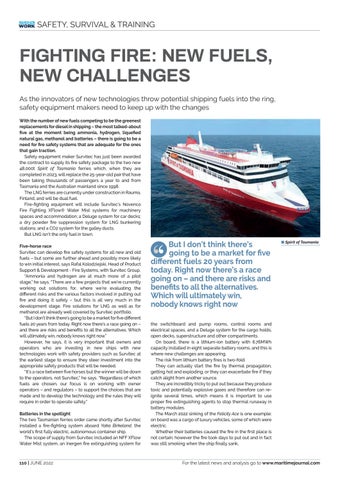SAFETY, SURVIVAL & TRAINING
FIGHTING FIRE: NEW FUELS, NEW CHALLENGES As the innovators of new technologies throw potential shipping fuels into the ring, safety equipment makers need to keep up with the changes With the number of new fuels competing to be the greenest replacements for diesel in shipping – the most talked-about five at the moment being ammonia, hydrogen, liquefied natural gas, methanol and batteries – there is going to be a need for fire safety systems that are adequate for the ones that gain traction. Safety equipment maker Survitec has just been awarded the contract to supply its fire safety package to the two new 48,000t Spirit of Tasmania ferries which, when they are completed in 2023, will replace the 25-year-old pair that have been taking thousands of passengers a year to and from Tasmania and the Australian mainland since 1998. The LNG ferries are currently under construction in Rauma, Finland, and will be dual fuel. Fire-fighting equipment will include Survitec’s Novenco Fire Fighting XFlow® Water Mist systems for machinery spaces and accommodation; a Deluge system for car decks; a dry powder fire suppression system for LNG bunkering stations; and a CO2 system for the galley ducts. But LNG isn’t the only fuel in town. Five-horse race Survitec can develop fire safety systems for all new and old fuels – but some are further ahead and possibly more likely to win initial interest, says Rafal Kolodziejski, Head of Product Support & Development - Fire Systems, with Survitec Group. “Ammonia and hydrogen are at much more of a pilot stage,” he says. “There are a few projects that we’re currently working out solutions for, where we’re evaluating the different risks and the various factors involved in putting out fire and doing it safely – but this is all very much in the development stage. Fire solutions for LNG as well as for methanol are already well covered by Survitec portfolio. “But I don’t think there’s going to be a market for five different fuels 20 years from today. Right now there’s a race going on – and there are risks and benefits to all the alternatives. Which will ultimately win, nobody knows right now.” However, he says, it is very important that owners and operators who are investing in new ships with new technologies work with safety providers such as Survitec at the earliest stage to ensure they steer investment into the appropriate safety products that will be needed. “It’s a race between five horses but the winner will be down to the operators, not Survitec,” he says. “Regardless of which fuels are chosen, our focus is on working with owner operators – and regulators – to support the choices that are made and to develop the technology and the rules they will require in order to operate safely.” Batteries in the spotlight The two Tasmanian ferries order came shortly after Survitec installed a fire-fighting system aboard Yaka Birkeland, the world’s first fully electric, autonomous container ship. The scope of supply from Survitec included an NFF XFlow Water Mist system, an Inergen fire extinguishing system for
110 | JUNE 2022
But I don’t think there’s going to be a market for five different fuels 20 years from today. Right now there’s a race going on – and there are risks and benefits to all the alternatives. Which will ultimately win, nobody knows right now
‘‘
8 Spirit of Tasmania
the switchboard and pump rooms, control rooms and electrical spaces, and a Deluge system for the cargo holds, open decks, superstructure and other compartments. On board, there is a lithium-ion battery with 6.76MWh capacity installed in eight separate battery rooms, and this is where new challenges are appearing. The risk from lithium battery fires is two-fold. They can actually start the fire by thermal propagation, getting hot and exploding, or they can exacerbate fire if they catch alight from another source. They are incredibly tricky to put out because they produce toxic and potentially explosive gases and therefore can reignite several times, which means it is important to use proper fire extinguishing agents to stop thermal runaway in battery modules. The March 2022 sinking of the Felicity Ace is one example: on board was a cargo of luxury vehicles, some of which were electric. Whether their batteries caused the fire in the first place is not certain; however the fire took days to put out and in fact was still smoking when the ship finally sank.
For the latest news and analysis go to www.maritimejournal.com











